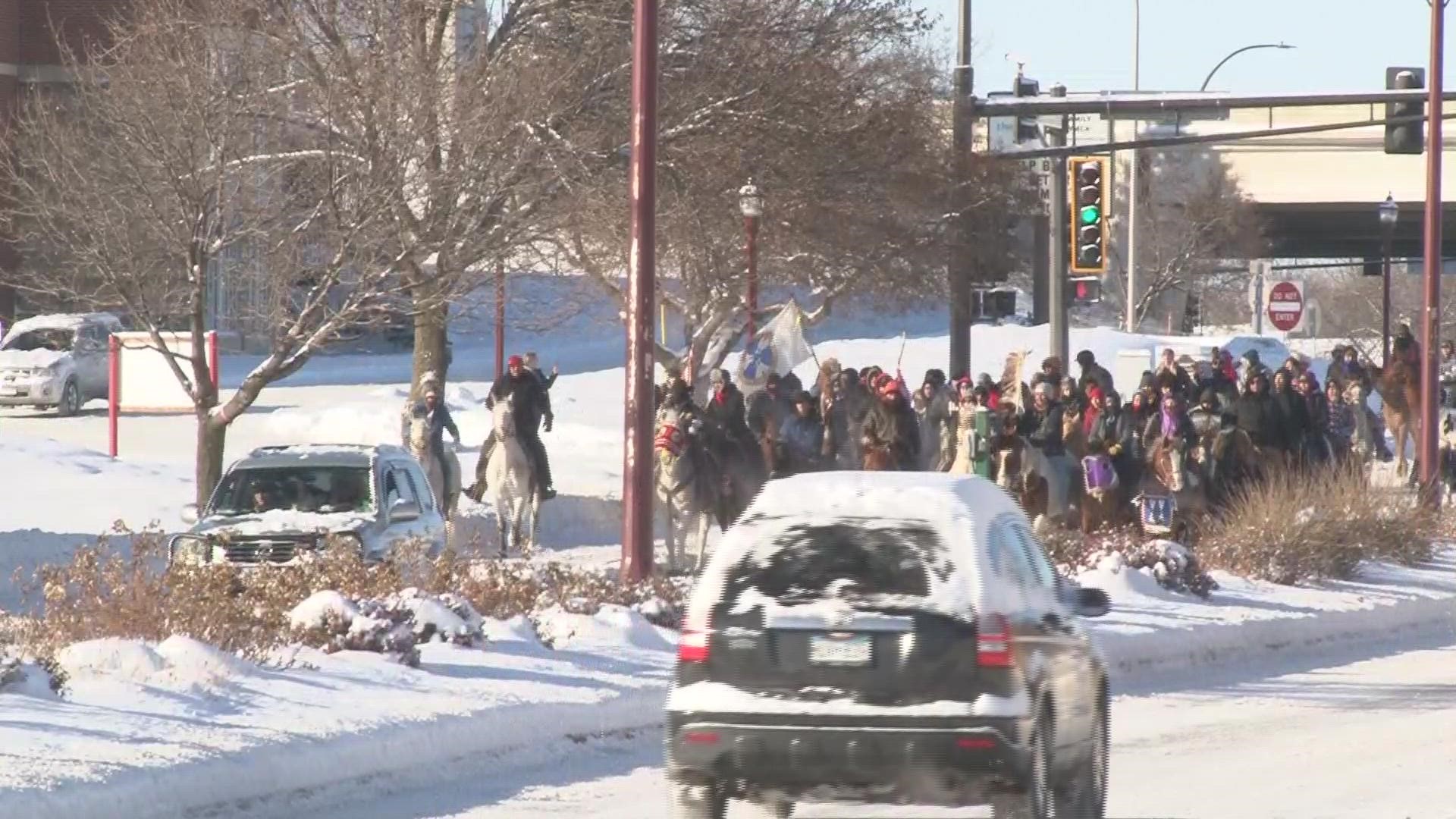MANKATO, Minn. — Indigenous people from Minnesota and bordering states gathered Monday to mark the 160th anniversary of the largest mass execution in American history. Among them were descendants of the 38 condemned Dakota men who were hanged for their roles in the U.S.-Dakota War of 1862.
The ceremony was at Reconciliation Park on Mankato's riverfront, which was also the end point of a 300-mile journey by horseback, dubbed "The Healing Ride" by some and the "Dakota 38 plus 2 Ride" by others. The "plus 2" refers to the executions of two chiefs, Sakpedan and Wakan Ozanzan, at Fort Snelling in 1864.
Melissa Dennis, a Cheyenne River Sioux member from Eagle Butte, South Dakota was among the 50 people who spent a week in the saddle, riding through horrible weather conditions on the journey to Mankato.
"There have been days I just want to cry, just going through the weather that was here. I can just imagine what our people went through. And they didn’t have all of this, they didn’t have all of this back then," Dennis told KARE 11 as she looked down at her extra layers of jackets and gloves.
She said she was familiar with the mass execution and the story of the condemned inmates singing in a Mankato church before being marched down to the gallows. But only recently she discovered she's connected by blood to one of the men who was hanged on Dec. 26, 1862.
"I'm a descendent of the man known as Chief White Dog. This is important. Honoring our people."
Hundreds of white European settlers perished in the war, which some Dakota men launched in August of 1862. Historians say the Dakota were starving and frustrated because supplies and money they'd been promised in exchange for ceding most of their land to the U.S. hadn't been released to them.
"It was an act of preservation and survival. And we’ve twisted that history around into something that it wasn’t," Sen. Mary Kunesh, a member of the Standing Rock Sioux Nation, told KARE 11.
"We’re not going to blame or point fingers, but make sure we’re at least for the next seven generations, we’re telling the truth of the matter."
Even as the U.S. Army was quelling the rebellion and capturing the Dakota combatants, then-Governor Alexander Ramsey became determined to push all Dakota people out of the state.
"The Sioux Indians of Minnesota must be exterminated or driven forever beyond the borders of the State," Ramsey told the state legislature.
Fueled by outrage over the slain settlers, Congress cooperated with Ramsey by passing laws that ended the previous treaties with the Dakota bands. And the U.S. Calvary, using Fort Snelling as its supply base, launched expeditions to remove more Dakota people.
Current Gov. Tim Walz, who was invited to speak at Monday's ceremony, began with an apology.
"As the governor of this state I stand here today to say how deeply sorry I am to the families who lost loved ones on this space, and all the things that followed that," Walz told the crowd at Reconciliation Park.
Walz is familiar with the story, having raised his family in Mankato and taught at a local high school before going to Congress. But he said it's important to teach this history to those beyond the city limits.
"This isn’t about condemnation. It isn’t about guilt. It’s about history that was real, and it’s telling that full history and understanding that indigenous perspective on the land," Walz explained.
"My office represents some of the most painful times in Indigenous history, especially for the Dakota."
In that winter of 1862-1863, another humanitarian tragedy was unfolding along the banks of the Minnesota River below Fort Snelling.
Government troops rounded up 1,600 Dakota women, children and old men in southwest Minnesota and marched them to a small make-shift prison camp below the fort. Historians estimate between 150 and 300 of them died from diseases and harsh conditions as they waited to be shipped by boat to a reservation in South Dakota.
"One of the ways we can honor those women and children is by teaching our children, native and non-native, the truth about the history of this state," Lt. Gov. Peggy Flanagan, a member of the White Earth Nation, told KARE 11.
Some of the prison families were documented in photographs that are now part of the Minnesota Historical Society's Collection. When asked what goes through her mind when she sees those photos, Flanagan spoke as a mother.
"You just think about wrapping your arms and your whole self around your child to keep them alive and you would be willing to do anything to protect them and keep them safe and warm."

